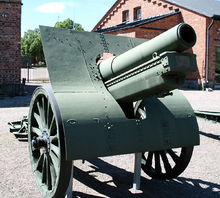152 mm howitzer M1909 / 30
The 152-mm howitzer M1909 / 30 ( Russian 152-мм гаубица обр. 1909/30 гг. ) Was a Russian heavy field howitzer with a caliber of 152.4 mm that was used during World War I and World War II .
history
As the name of the gun , M09 / 30, implies, the howitzer was developed for tsarist Russia in 1909. However, the guns survived the war because they were based on a relatively advanced concept. The weapons were eventually taken over by the Red Army . It was decided to keep these guns until more effective weapons were available. In 1930 these weapons were modernized, as only with the M1931 with the caliber 203 mm were more modern weapons available from 1931. However, M1931 was never produced in sufficient numbers. It was not until 1937 that the Russian designers developed new howitzers in caliber 152 mm. For this reason, the last M09 / 30 howitzers were still in service with the Red Army at the beginning of Operation Barbarossa , the attack by the Wehrmacht in 1941.
technology
What is striking about the M09 / 30 is the curved shield that almost completely covered the spoked wheels. This had the disadvantage that mud and dirt could spread more easily on the loading mechanism, making it unusable. A single spar with a ground spur gave the weapon a more stable position during recoil . As with today's guns, the barrel was returned via the actual loading cradle. This was an innovation in 1909, but was already standard at the time of the First World War. For loading, the propellant and projectile were simply placed on the shell and pushed into the barrel.
When weapons were modernized in 1930, the main focus was on optimizing them for motorized transport or power train. At the same time, however, it should still be ensured that transport by horses was possible. To do this, the mount had to be changed. Further improvements were a stronger propellant charge and a smaller projectile.
Technical specifications
| 152 mm howitzer M1909 / 30 | |
| General properties | |
| classification | heavy body hood |
| developer | French company Schneider in 1909, modernization in Zavod No.172 in 1930 |
| Manufacturer | Permsky Sawod No.172 (Perm-Werke No.172, Russian Пермский завод №172) |
| Length with limber | 5835 mm |
| width | 1890 mm |
| height | 1920 mm |
| Weight in firing position | 2810 kg |
| Weight in driving position | 3270 kg |
| team | 8 men (gun leader, two gunner, five loaders and ammunition shooters) |
| Years of construction | 1931-1941 |
| number of pieces | 2,188 |
| pipe | |
| caliber | 152.4 mm |
| Pipe length | 2160 mm (L / 14) |
| Tube length (drawn barrel) | 1996 mm (L / 13.1) |
| Height of the line of fire | 1314 mm |
| Fire dates | |
| Elevation range | 0 ° to 41 ° |
| Side straightening area | 2 ° 50 ' |
| Maximum range | 8,800 m |
| Maximum muzzle velocity | 391 m / s |
| fire rate | 5-6 rounds / min |
| agility | |
| Ground clearance | 580 mm |
| Top speed in a power train | 12 km / h |
Others
Like many others, the M 1909/30 and the associated ammunition were captured by the Wehrmacht in large numbers during the German attack on the Soviet Union . On the German side it was used for coastal defense under the name 15.2 cm heavy field howitzer 445 (r) (r for Russian).
Individual references / comments
- ↑ AB Shirokorad : Encyclopedia of the Russian Artillery.
literature
- А.Б. Широкорад: Энциклопедия отечественной артиллерии. (AB Shirokorad: Encyclopedia of Russian Artillery. ) Harvest, Minsk 2000, ISBN 985-433-703-0 (Russian).
- Ian Hogg : 20th Century Artillery. Gondrom Verlag, Bindlach 2001, ISBN 3-8112-1878-6 .
- Terry Gander, Peter Chamberlain: Encyclopedia of German Weapons 1939-1945. 2nd edition, special edition, Motorbuchverlag, Stuttgart 2006, ISBN 3-613-02481-0 .


